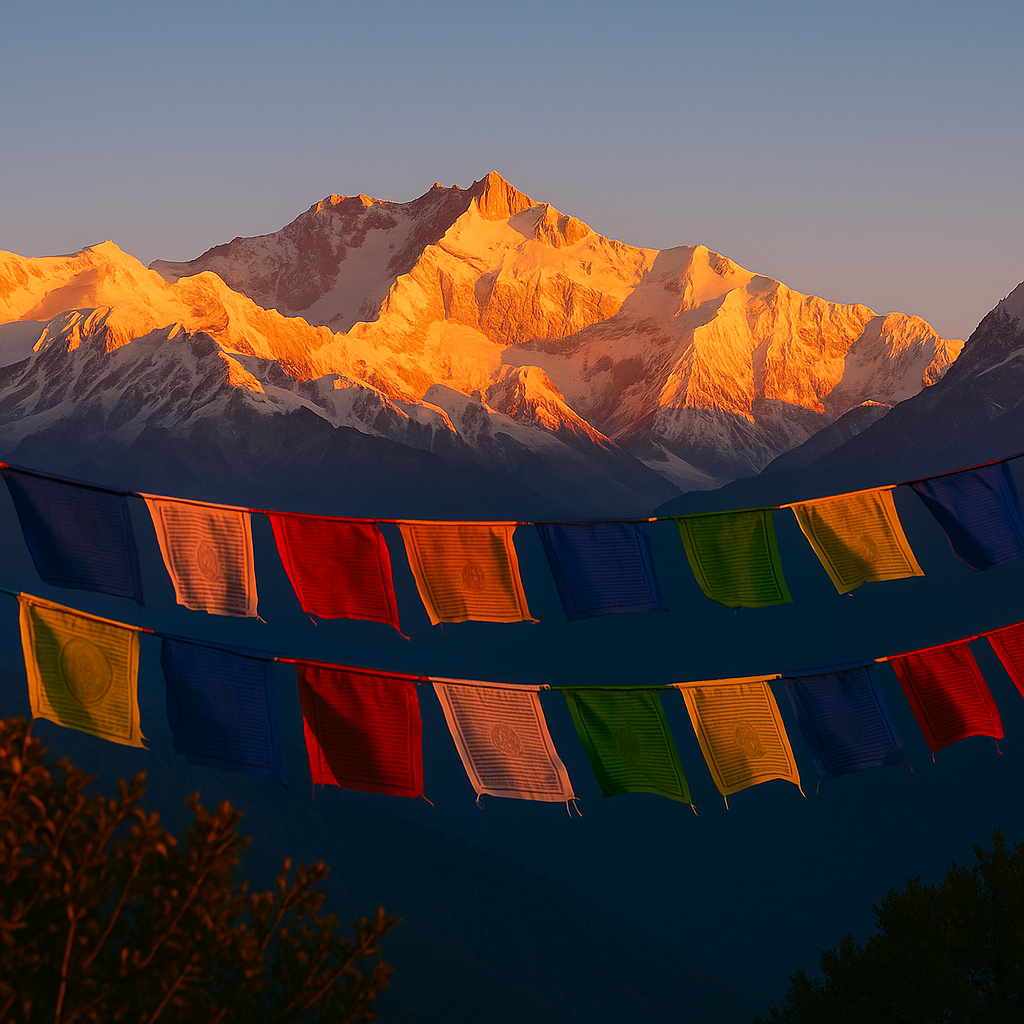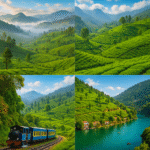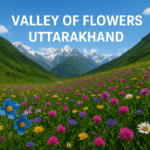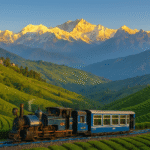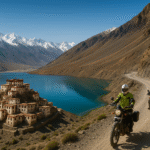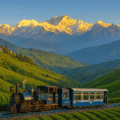High up in the Eastern Himalayas, surrounded by towering snow peaks and lush valleys, lies Sikkim, one of India’s most breathtaking and culturally vibrant states. 🏔️ Despite being the second smallest state in India, Sikkim’s charm is unmatched—it offers adventure, peace, spirituality, and natural beauty in one magical package.
Often called the “Organic Paradise of India” 🌱, Sikkim is the first Indian state to become fully organic in farming. It’s also a hub of cultural harmony, where Lepchas, Bhutias, and Nepalis live together, celebrating diverse festivals and traditions.
From the snow-clad Kanchenjunga ⛰️ to the flower-filled Yumthang Valley, from ancient monasteries echoing with chants 🕉️ to bustling markets filled with colorful handicrafts, Sikkim is a traveler’s dream. Let’s take a deep dive into everything about this Himalayan wonderland.
📍 Geography & Location of Sikkim
Sikkim is a tiny Himalayan state with a big heart.
- Total Area: 7,096 sq. km (22nd state of India).
- Capital: Gangtok 🏙️
- Borders:
- North & East: Tibet (China) 🇨🇳
- West: Nepal 🇳🇵
- South: West Bengal 🇮🇳
- Southeast: Bhutan 🇧🇹
Despite its size, Sikkim has diverse terrains:
- Tropical forests in the south 🌳
- Alpine meadows in the north 🌸
- Snow-capped Himalayan peaks in the west ❄️
🏔️ The pride of Sikkim is Mount Kanchenjunga (8,586 m), the world’s third-highest mountain, worshipped by locals as a guardian deity.
📖 A Glimpse into Sikkim’s History
Sikkim’s history is as fascinating as its landscapes.
🏔️ Ancient Times
- Originally inhabited by the Lepchas, known as the “Children of the Snowy Peaks.”
- Later, Tibetan Bhutias and Nepali settlers added cultural richness.
👑 Kingdom of Sikkim
- In 1642, Phuntsog Namgyal became the first Chogyal (king) of Sikkim.
- The monarchy continued for over 300 years.
🏰 British & Indian Era
- In the 19th century, Sikkim came under British influence during Anglo-Nepalese wars.
- After India’s independence, Sikkim remained a protectorate under the Indo-Sikkim Treaty (1950).
- In 1975, after a referendum, Sikkim officially became the 22nd state of India. 🇮🇳
Today, Sikkim blends its royal past with modern progress, balancing tradition and development.
🧘 Culture & Traditions of Sikkim
Sikkim is a melting pot of cultures where harmony defines everyday life.
🌈 Communities
- Lepchas: The original inhabitants, deeply connected with nature 🌳.
- Bhutias: Tibetan-origin settlers who brought Buddhism and monasteries 🕉️.
- Nepalis: The largest community today, contributing festivals, dances & food.
🎉 Festivals
- Losar: Tibetan New Year 🥳
- Saga Dawa: Honoring Buddha’s birth, enlightenment & death 🌕
- Pang Lhabsol: Worship of Mount Kanchenjunga ⛰️
- Dasain & Tihar: Nepali festivals with lights & family gatherings 🎇
- Maghe Sankranti & Bhumchu: Hindu-Buddhist mixed celebrations
👗 Traditional Dress
- Men: Bakhu (robe) tied with a belt.
- Women: Kho & Honju (elegant silk dresses with jewelry 💍).
🎶 Art, Dance & Music
- Folk dances: Chu-Faat (offering to Kanchenjunga), Maruni (Nepali dance).
- Music: Dranyen (Tibetan lute) & traditional Nepali tunes 🎵.
🏞️ Top Tourist Attractions in Sikkim
🌆 1. Gangtok – The Capital
- Ropeway rides 🚠
- MG Marg – cafes, shops, nightlife 🌃
- Rumtek Monastery – seat of Karma Kagyu Buddhism 🕍
❄️ 2. Tsomgo Lake (Changu Lake)
- At 12,310 ft, surrounded by snowy peaks ❄️
- Yak rides 🐂 and colorful prayer flags
🏔️ 3. Nathula Pass
- At 14,140 ft, Indo-China border point 🌏
- Historic Silk Route 🛤️
🌸 4. Yumthang Valley – Valley of Flowers
- Rhododendron sanctuary 🌺
- Hot springs ♨️
🏡 5. Lachen & Lachung
- Gateway to Gurudongmar Lake 💧
- Snowy mountain villages 🏠
💧 6. Gurudongmar Lake
- At 17,800 ft, one of the highest lakes in the world 🌍
- Sacred to Buddhists, Hindus & Sikhs
🏯 7. Pelling
- Pemayangtse Monastery 🕍
- Sky Walk with glass bridge 🌉
- Kanchenjunga views 🌄
🕉️ 8. Namchi & Ravangla
- Buddha Park (130 ft statue) 🙏
- Guru Padmasambhava statue (118 ft)
🛶 9. Zuluk & Silk Route
- Offbeat destination with hairpin bends 🚗
- Sunrise views at Thambi Viewpoint 🌅
🧗 Adventure Activities in Sikkim
For thrill-seekers, Sikkim is paradise:
- 🥾 Trekking: Goecha La Trek, Dzongri Trek, Kanchenjunga Base Camp.
- 🌊 River Rafting: Rapids of Teesta & Rangit rivers.
- 🪂 Paragliding: Gangtok & Yumthang.
- 🚴 Mountain Biking: Rugged Himalayan trails.
- ❄️ Snow Adventures: Snowball fights & yak rides at Nathula & Tsomgo.
🍲 Cuisine of Sikkim
Food in Sikkim reflects Tibetan, Nepali, and Lepcha influences.
- 🥟 Momos – steamed dumplings with chili chutney.
- 🍜 Thukpa – Tibetan noodle soup.
- 🥬 Gundruk & Sinki – fermented leafy greens.
- 🐖 Phagshapa – pork with radish.
- 🍞 Sael Roti – rice flour bread.
- ☕ Butter Tea – salty Tibetan-style tea.
- 🍹 Tongba – millet-based alcoholic drink (served in bamboo).
🌿 Flora & Fauna of Sikkim
Sikkim is part of the Eastern Himalaya Biodiversity Hotspot.
- 🌸 Plants: 4,500+ species of flowering plants, 600 orchids.
- 🐼 Animals: Red Panda (state animal), snow leopards, Himalayan bears.
- 🪶 Birds: Blood Pheasant (state bird), Himalayan Monal.
- 🌳 National Parks: Khangchendzonga National Park (UNESCO site).
🌤️ Climate & Best Time to Visit
- Summer (Mar–Jun): Pleasant, 10–25°C 🌞
- Monsoon (Jul–Sep): Heavy rains, landslides possible 🌧️
- Autumn (Oct–Nov): Clear skies, great for treks 🍁
- Winter (Dec–Feb): Snow in higher altitudes ❄️
👉 Best months: March–June & October–November.
🚌 How to Reach Sikkim
- By Air: Pakyong Airport ✈️ (closest), Bagdogra Airport (120 km).
- By Train: Nearest railway station – New Jalpaiguri (NJP), 148 km. 🚆
- By Road: Connected via National Highway 10 from Siliguri. 🚗
💡 Travel Tips for Sikkim
✔️ Inner Line Permits required for foreigners & Nathula.
✔️ Carry woolens 🧥 even in summer (nights are cold).
✔️ Respect monasteries & local customs 🙏.
✔️ Avoid plastic (Sikkim is eco-friendly 🌿).
✔️ Keep buffer days during monsoon.
💵 Economy & Lifestyle in Sikkim
- Agriculture: 100% organic farming 🌱.
- Tourism: Major contributor to GDP 🏞️.
- Hydropower: Sikkim exports electricity ⚡.
- Lifestyle: Peaceful, eco-conscious, community-driven. 🧘
🌟 Why Visit Sikkim?
- 🏔️ To see Kanchenjunga in its full glory.
- 🌸 To walk in flower valleys.
- 🧘 To find peace in monasteries.
- 🪂 To experience Himalayan adventure.
- 🥟 To enjoy unique Sikkimese cuisine.
- 🌿 To explore India’s first organic state.
📝 Conclusion
Sikkim is not just a state—it’s an experience of nature, spirituality, and adventure. 💖 From snow peaks to prayer flags fluttering in the wind, from yak rides at frozen lakes to peaceful evenings in monasteries, every corner of Sikkim whispers magic. ✨
If you’re planning your next trip, let Sikkim be your Himalayan escape—where nature heals, culture inspires, and adventure awaits. 🌏
❓ Frequently Asked Questions (FAQs) About Sikkim
1. 🌏 Where is Sikkim located?
Sikkim is a northeastern state of India, nestled in the Himalayas. It shares borders with Nepal, Bhutan, Tibet (China), and West Bengal.
2. 🏔️ What is the best time to visit Sikkim?
The best time is March–June (spring & summer) and October–November (autumn) when the weather is pleasant, skies are clear, and flowers bloom.
3. 🕉️ What is Sikkim famous for?
Sikkim is famous for Kanchenjunga Mountain, monasteries, organic farming, rhododendrons, adventure treks, momos, and the Red Panda 🐼.
4. 🛶 What are the must-visit places in Sikkim?
- Gangtok
- Tsomgo Lake
- Nathula Pass
- Yumthang Valley
- Gurudongmar Lake
- Pelling
- Namchi & Ravangla
5. 🍲 What is the traditional food of Sikkim?
Popular dishes include Momos, Thukpa, Phagshapa, Gundruk, Sinki, Sael Roti, and Butter Tea.
6. 🧗 What are the adventure activities in Sikkim?
Trekking, river rafting, mountain biking, paragliding, and yak rides at high-altitude lakes.
7. 📜 When did Sikkim become a part of India?
Sikkim officially became the 22nd state of India in 1975 after a referendum.
8. 🌿 Is Sikkim an organic state?
Yes ✅, Sikkim is India’s first fully organic state, where all farming practices are chemical-free.
